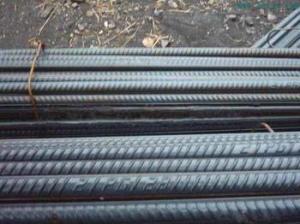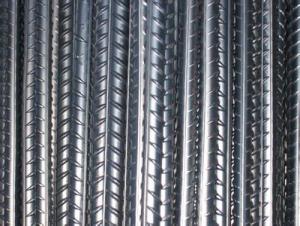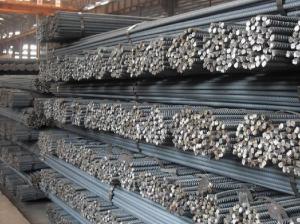Hot -rolled bar 400MPa
- Loading Port:
- China Main Port
- Payment Terms:
- TT OR LC
- Min Order Qty:
- -
- Supply Capability:
- -
OKorder Service Pledge
OKorder Financial Service
You Might Also Like
HRB400 is a kind of name of the new standard of reinforced, as one of the hot rolled ribbed steel bar. The name of the new standard for HRB400 reinforced, tertiary rebar for old said, as one of the hot rolled ribbed steel bar. In the construction industry, tertiary rebar is the last term.
Of the brand by HRB and number of hot rolled ribbed steel bar yield point of the minimum value. H, R, B Hot rolled (Hot rolled) respectively, ribbed (ribbed), steel bar (Bars) the first three words of English letters.
Classification of HRB400 -
Divided into HRB335 hot rolled ribbed bar (Numbers of 20 mnsi), HRB400 (the old number is 20 mnsiv, 20 mnsinb, 20 mnti), HRB500 three grades.
Fine grain hot-rolled reinforced its brands after the abbreviation of hot rolled ribbed steel bar and "Fine" (Fine), the first letter in English. Such as: HRBF335, HRBF400, HRBF500.
Have higher requirements of aseismatic structures for brand is: after the existing brand and E (for example: HRB400E, HRBF400E).
HRB400 - main purposes
Widely used in houses, Bridges, roads and other civil engineering construction.
HRB400 - leading producer
Rebar manufacturers in our country mainly in north and northeast, north China area such as shougang, tangshan, xuanhua, ChengGang, shanxi ZhongYang steel mills, baoding pury steel, northeast Westwood, north Taiwan, stroke, such as steel and so on, the two regions more than about 50% of the total output of rebar.
Rebar and light surface is the difference between a round bar with longitudinal and transverse ribs, usually with 2 longitudinal and cross rib of uniform distribution along the length direction. Belong to small section steel rebar, mainly used for reinforced concrete frame construction. In use requires a certain mechanical strength, bending deformation properties and welding performance. Production of raw materials of rebar steel billet calm smelting process in the carbon structural steel and low alloy structural steel, finished steel for hot rolling forming, is fire or hot rolling state delivery.
HRB400 - reverse bending performance
According to buyer's requirements, the rebar can reverse bending performance test.
Reverse bending test of curved heart diameter than the corresponding increase a rebar diameter bend test. Positively curved 45 degree first, and then reverse bending 23 degrees, reverse bending after 23 degrees. After reverse bend test, rebar bending parts surface shall not crack.
HRB400 - surface quality
Rebar surface permits can not have crack, scarring, and folding.
Rebar surface with convex block is allowed, but must not exceed the height of the horizontal rib, other defect depth and height of the rebar surface shall not be greater than their positions to allow the size deviation.
HRB400 - size, shape, weight, and allowable deviation
1. Nominal diameter range and recommend the diameter
Rebar nominal diameter in the range of 6 ~ 25 mm, standards recommended by the rebar nominal diameter is 6, 8, 10, 12, 16, 20, 25, 32, 40, 50 mm.
2. The ribbed steel plate surface shape and size of allowable deviation
Ribbed rebar cross rib shall meet the following basic requirements:
Axis transverse ribs with steel plate of beta should not be less than 45 degree Angle, when the Angle is not greater than 70 degrees, rebar relative to the direction of the horizontal rib on both sides should instead;
L cross rib and spacing shall not be greater than the rebar nominal diameter of 0.7 times;
Horizontal rib on the side and Angle on the surface of the rebar shall not be less than 45 degrees;
Rebar clearance between relative to the end of cross rib on both sides (including the longitudinal rib width) should not be greater than the sum rebar 20% of nominal circumference;
When the rebar nominal diameter is not more than 12 mm, relative costal area should not be less than 0.055; nominal diameter is 14 mm and 16 mm, relative costal area should not be less than 0.060; Nominal diameter greater than 16 mm, relative costal area should not be less than 0.065.
3. Length and allowable deviation
A, length: rebar usually according to the specified length delivery, specific delivery length should be indicated in the contract; rebar to volume delivery, each dish should be a rebar, allowing each group of 5% plate number (less than two sets can have two sets) consists of two rebar. Its diameter disc weight and plate shall be formulated by the supply and demand both sides talks things over.
B, the length of the allowable deviation: rebar according to scale the length of the delivery of the allowable deviation shall not be greater than + 50 mm.
C, bending and end: straight rebar bending change should not affect the normal use, the total curvature is not more than 40% of the total length of screw thread; Rebar ends should be cut integrity, local deformation shall not influence the use. [1]
HRB400 - need to detect project
Inspection items include: certificate number, rolling furnace number, grade, chemical composition (C, Si, Mn, P, V), tensile strength, yield point, elongation, relaxation rate, sectional area, product name, specification, quantity, delivery date, executive standard, receiving unit, etc. Only after inspection qualified can be for rebar, the acceptance of work.
- Q:What are the weight and density of steel rebars?
- Steel rebars, also known as reinforcing bars, are commonly used in construction to provide tensile strength to concrete structures. The weight and density of steel rebars can vary depending on their size and grade. The weight of a steel rebar is determined by its cross-sectional area and the specific weight of steel, which is approximately 7850 kilograms per cubic meter (or 0.2836 pounds per cubic inch). The cross-sectional area is typically measured in square millimeters or square inches. For example, a common size of steel rebar is the #4 bar, which has a diameter of 12.7 millimeters (or 0.5 inches) and a cross-sectional area of 127 square millimeters (or 0.197 square inches). Using the specific weight of steel, we can calculate the weight of a #4 rebar as follows: Weight = Cross-sectional area x Specific weight of steel Weight = 127 mm^2 x 7850 kg/m^3 Weight = 998,950 grams or approximately 998.95 kilograms (or 2,201 pounds) In terms of density, the density of steel rebars is the same as the specific weight of steel, which is approximately 7850 kilograms per cubic meter. This density is relatively consistent across different sizes and grades of steel rebars. It is important to note that the weight and density of steel rebars can vary slightly depending on the specific composition and manufacturing process. Therefore, it is always recommended to refer to the manufacturer's specifications or consult engineering references for accurate and up-to-date information.
- Q:What is the role of steel rebars in bridge deck construction?
- The construction of bridge decks relies heavily on steel rebars, which play a vital role in reinforcing the concrete. Their main purpose is to enhance the tensile strength of the concrete since it is naturally strong in compression but weak in tension. Bridge decks are subject to various loads, including the weight of vehicles, live loads, temperature changes, and vibrations from the environment. Insufficient tensile strength in the bridge deck can result in bending, cracking, or even collapse under these loads. By incorporating steel rebars into the concrete structure of the bridge deck, the tensile strength is significantly improved. These rebars are strategically placed throughout the concrete to effectively distribute loads and resist tension, preventing cracks and ensuring the overall structural integrity of the bridge. Aside from reinforcing the concrete, steel rebars also serve to control cracks caused by shrinkage or thermal expansion. When the concrete shrinks or expands, cracks can form, compromising the durability and stability of the bridge. However, the inclusion of rebars helps to regulate and limit the size and extent of these cracks, ensuring the long-term performance of the bridge. Moreover, steel rebars also assist in transferring loads between different components of the bridge, such as the bridge deck and the supporting piers or abutments. They facilitate the creation of a continuous load path, guaranteeing efficient transmission and distribution of loads throughout the bridge structure. To summarize, the presence of steel rebars is crucial in bridge deck construction as they provide the necessary tensile strength to the concrete. They enhance the structural integrity of the bridge, control cracks, and enable efficient load transfer, ultimately ensuring the safety and longevity of the bridge.
- Q:Can steel rebars be used in architectural concrete elements?
- Yes, steel rebars can be used in architectural concrete elements. They provide additional strength and reinforcement to the concrete structure, ensuring its durability and stability. Steel rebars are commonly used in architectural designs such as columns, beams, and slabs to enhance the overall structural integrity of the concrete elements.
- Q:How do steel rebars affect the overall seismic performance of a structure?
- The overall seismic performance of a structure is greatly enhanced by steel rebars. Seismic events, like earthquakes, exert dynamic forces on buildings, causing them to vibrate and possibly collapse. However, incorporating steel rebars in concrete structures significantly enhances their ability to withstand these forces and ensures the safety of those inside. First and foremost, steel rebars strengthen a building's structure. By reinforcing the concrete, they increase its tensile strength since concrete alone is weak in tension. During an earthquake, the rebars help distribute the dynamic forces throughout the structure, preventing stress concentration in specific areas. This redistribution of forces minimizes the risk of localized failures and maintains the stability of the structure. Moreover, steel rebars improve the ductility of a structure. Ductility refers to a material's ability to deform under stress without breaking. During an earthquake, buildings undergo significant lateral movements and deformations. Steel rebars, with their high ductility, can elongate and stretch without fracturing, absorbing and dissipating the seismic energy. This property enables the structure to withstand larger ground motions and reduces the chance of sudden collapse. Furthermore, steel rebars enhance the overall resilience of a structure. Resilience refers to a building's ability to quickly recover its functionality after an earthquake. By reinforcing the concrete, steel rebars contribute to the post-earthquake repairability of the structure. They ensure that the building maintains its load-carrying capacity even after sustaining damage, which reduces downtime and allows for a faster recovery. Additionally, steel rebars serve as a warning sign for potential structural issues. During an earthquake, cracks may appear in the concrete, indicating areas of stress concentration. These cracks are often visible around the rebars, acting as an early indication of structural vulnerability. This visual warning allows for timely inspection and repair, preventing further damage and ensuring the long-term safety of the building. In conclusion, steel rebars play a crucial role in enhancing the overall seismic performance of a structure. Their inclusion in concrete greatly improves structural integrity, increases ductility, enhances resilience, and provides visual warnings of potential issues. By reinforcing the concrete, steel rebars ensure that buildings can withstand seismic forces, reducing the risk of collapse and ensuring the safety of occupants during earthquakes.
- Q:What is the process of bending steel rebars?
- The process of bending steel rebars typically involves using a specialized machine called a rebar bender. The rebars, which are long, thin rods made of steel, are positioned on the bender machine and clamped securely. The operator then uses the machine's controls to apply force and gradually bend the rebar to the desired angle or shape. The bending process requires precision and may involve multiple bends depending on the specific project requirements.
- Q:What is the standard size of a steel rebar?
- The standard size of a steel rebar typically ranges from 6mm to 50mm in diameter.
- Q:What are the common methods of cutting steel rebars on construction sites?
- There are several common methods used to cut steel rebars on construction sites. These methods are chosen based on the specific requirements of the project and the available equipment. One commonly used method is using a rebar cutter, which is a handheld tool specifically designed for cutting steel rebars. These cutters are operated manually and can easily cut through rebars of varying diameters. They are convenient to use on-site due to their portability and ease of operation. Another method is using a chop saw, also known as a cut-off saw or an abrasive saw. This method involves using a high-speed abrasive disc to make precise cuts on the steel rebars. Chop saws are commonly used when there is a need for accurate and clean cuts, especially when multiple rebars need to be cut to the same length. Oxy-fuel cutting is another method that can be used for cutting steel rebars. This method involves using a torch that combines oxygen and a fuel gas, typically acetylene, to create a high-temperature flame. The intense heat generated by the torch can effectively cut through steel rebars of varying thicknesses. Oxy-fuel cutting is often used when there is a need for rapid cutting or when dealing with thicker rebars. Plasma cutting is also a popular method for cutting steel rebars. This technique uses a high-velocity jet of ionized gas, known as plasma, to melt and remove the metal. Plasma cutting is suitable for cutting rebars of different thicknesses and can achieve precise and clean cuts. It is often used when working with rebars that have intricate shapes or when there is a need for fast and accurate cutting. It is important to note that safety precautions should always be followed when cutting steel rebars on construction sites. This includes wearing appropriate personal protective equipment, such as safety glasses, gloves, and hearing protection. Additionally, proper training and supervision are crucial to ensure the correct use of cutting equipment and to minimize the risk of accidents or injuries.
- Q:How do steel rebars prevent cracks in concrete structures?
- Steel rebars prevent cracks in concrete structures by providing reinforcement and increasing the tensile strength of the concrete. When concrete is exposed to tensile forces, such as those caused by external loads or temperature changes, it tends to crack. However, steel rebars, which are embedded within the concrete, act as a reinforcement and absorb these tensile forces. The rebars distribute the load more evenly throughout the structure, preventing localized stress and minimizing the formation of cracks.
- Q:Are there any specific guidelines for storing and handling steel rebars?
- Yes, there are specific guidelines for storing and handling steel rebars. These guidelines typically include storing rebars on a flat surface to prevent bending and distortion, keeping them off the ground to prevent rusting, and protecting them from moisture and exposure to chemicals. Additionally, rebars should be handled with care to avoid any damage or injury, and they should be stored in a well-organized manner to ensure easy identification and retrieval.
- Q:What is the lifespan of steel rebars in different environments?
- The lifespan of steel rebars can vary depending on the environment they are exposed to. In general, steel rebars have a long lifespan and can last for many decades in most environments. However, in harsh or corrosive environments such as coastal areas with high salt content or industrial areas with chemical exposure, the lifespan may be reduced. Proper maintenance and protective measures, such as coatings or cathodic protection, can significantly increase the lifespan of steel rebars in these environments.
1. Manufacturer Overview |
|
|---|---|
| Location | |
| Year Established | |
| Annual Output Value | |
| Main Markets | |
| Company Certifications | |
2. Manufacturer Certificates |
|
|---|---|
| a) Certification Name | |
| Range | |
| Reference | |
| Validity Period | |
3. Manufacturer Capability |
|
|---|---|
| a)Trade Capacity | |
| Nearest Port | |
| Export Percentage | |
| No.of Employees in Trade Department | |
| Language Spoken: | |
| b)Factory Information | |
| Factory Size: | |
| No. of Production Lines | |
| Contract Manufacturing | |
| Product Price Range | |
Send your message to us
Hot -rolled bar 400MPa
- Loading Port:
- China Main Port
- Payment Terms:
- TT OR LC
- Min Order Qty:
- -
- Supply Capability:
- -
OKorder Service Pledge
OKorder Financial Service
Similar products
New products
Hot products
Related keywords





























